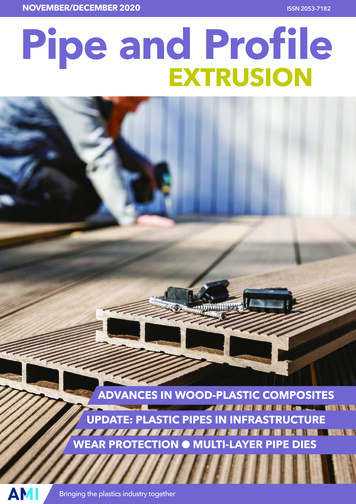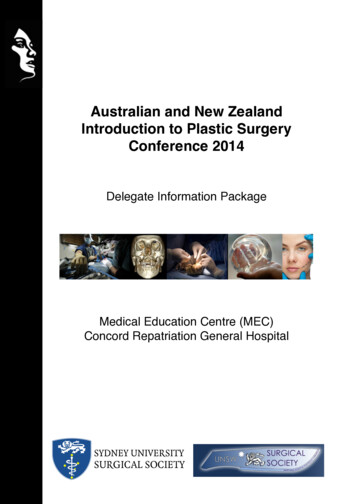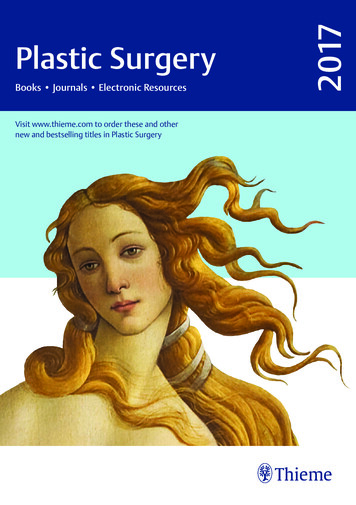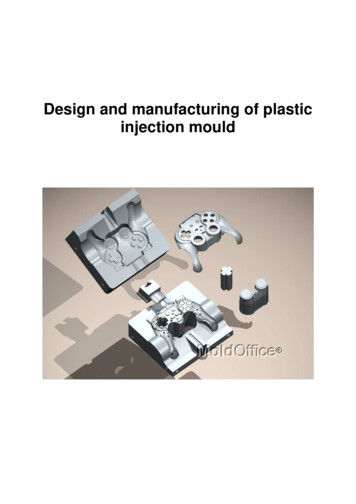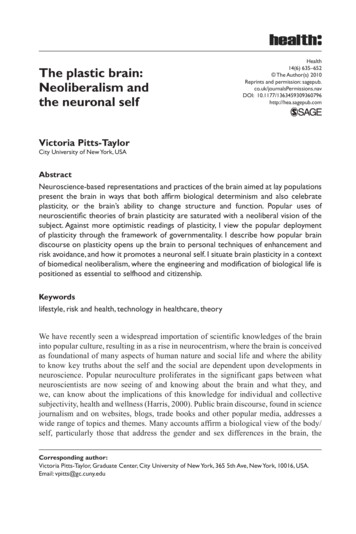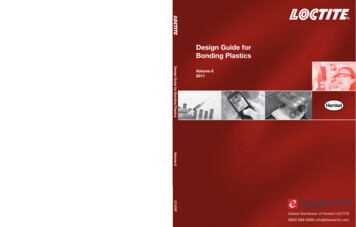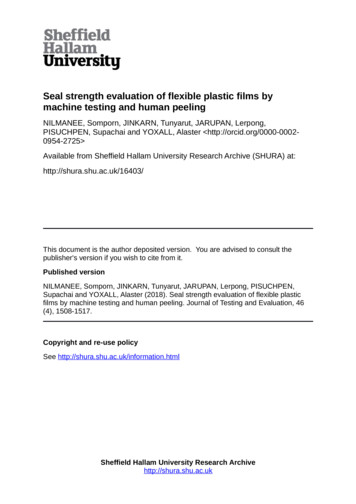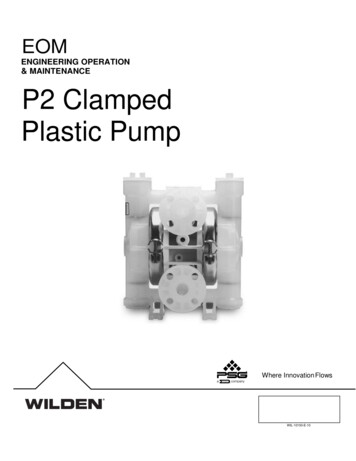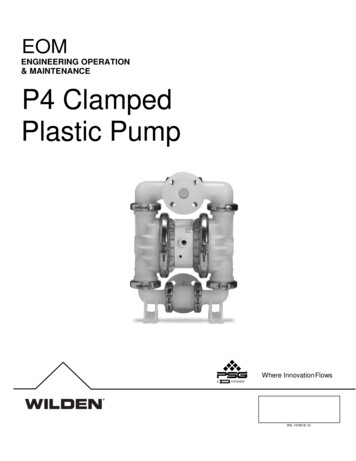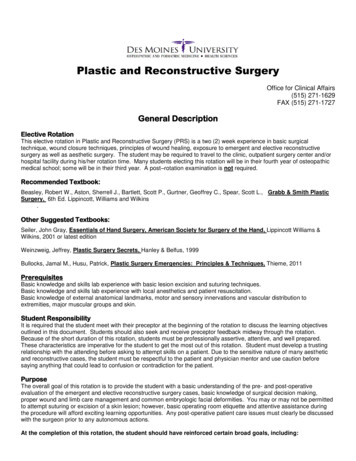
Transcription
Plastic and Reconstructive SurgeryOffice for Clinical Affairs(515) 271-1629FAX (515) 271-1727General DescriptionElective RotationThis elective rotation in Plastic and Reconstructive Surgery (PRS) is a two (2) week experience in basic surgicaltechnique, wound closure techniques, principles of wound healing, exposure to emergent and elective reconstructivesurgery as well as aesthetic surgery. The student may be required to travel to the clinic, outpatient surgery center and/orhospital facility during his/her rotation time. Many students electing this rotation will be in their fourth year of osteopathicmedical school; some will be in their third year. A post–rotation examination is not required.Recommended Textbook:Beasley, Robert W., Aston, Sherrell J., Bartlett, Scott P., Gurtner, Geoffrey C., Spear, Scott L., Grabb & Smith PlasticSurgery, 6th Ed. Lippincott, Williams and Wilkins.Other Suggested Textbooks:Seiler, John Gray, Essentials of Hand Surgery, American Society for Surgery of the Hand, Lippincott Williams &Wilkins, 2001 or latest editionWeinzweig, Jeffrey, Plastic Surgery Secrets, Hanley & Belfus, 1999Bullocks, Jamal M., Husu, Patrick, Plastic Surgery Emergencies: Principles & Techniques, Thieme, 2011PrerequisitesBasic knowledge and skills lab experience with basic lesion excision and suturing techniques.Basic knowledge and skills lab experience with local anesthetics and patient resuscitation.Basic knowledge of external anatomical landmarks, motor and sensory innervations and vascular distribution toextremities, major muscular groups and skin.Student ResponsibilityIt is required that the student meet with their preceptor at the beginning of the rotation to discuss the learning objectivesoutlined in this document. Students should also seek and receive preceptor feedback midway through the rotation.Because of the short duration of this rotation, students must be professionally assertive, attentive, and well prepared.These characteristics are imperative for the student to get the most out of this rotation. Student must develop a trustingrelationship with the attending before asking to attempt skills on a patient. Due to the sensitive nature of many aestheticand reconstructive cases, the student must be respectful to the patient and physician mentor and use caution beforesaying anything that could lead to confusion or contradiction for the patient.PurposeThe overall goal of this rotation is to provide the student with a basic understanding of the pre- and post-operativeevaluation of the emergent and elective reconstructive surgery cases, basic knowledge of surgical decision making,proper wound and limb care management and common embryologic facial deformities. You may or may not be permittedto attempt suturing or excision of a skin lesion; however, basic operating room etiquette and attentive assistance duringthe procedure will afford exciting learning opportunities. Any post-operative patient care issues must clearly be discussedwith the surgeon prior to any autonomous actions.At the completion of this rotation, the student should have reinforced certain broad goals, including:
Basic understanding of reconstructive pre- and post-operative patient management.Learn the techniques of gentle tissue management in skin closure, trauma (burns), flap rotation and skingrafting.Basic knowledge of congenital facial and extremity birth defects.Basic knowledge of reconstruction after oncologic procedures of the breast, melanoma and head andneck cancers.Students are expected to assist in the management of preoperative, perioperative and postoperative patient careunder supervision. The student should also develop fundamental psychosocial skills by observing physicianpatient interactions during this rotation.We recognize that two weeks is an insufficient amount of time to cover a comprehensive list of objectives in any area ofpractice. Clearly, subjects addressed in any clinical rotation are dependent on the numbers of patients and kinds ofdisease entities presenting to a particular service. Nevertheless, certain minimum content must be addressed, either byclinical exposure or by didactic materials so that students are prepared for Board examinations and other testing. Broadgoals listed above are a minimum; objectives for rotations not specifically listed in these guidelines should include theAffective Objectives listed below. The College depends on the supervising physician to establish more specific objectivesdealing with the scope of the particular specialty. Therefore, the following sections contain relatively broad, basicobjectives for which students are responsible.CompetenciesOsteopathic Philosophy and Osteopathic Manipulative MedicineOBJECTIVES: Osteopathic Philosophy and Osteopathic Manipulative Medicine1. Demonstrate the ability to perform and record an osteopathic structural examination on a surgical patient anddocument such using acceptable osteopathic terminology.2. Demonstrate the application of the osteopathic philosophy into the pre- and post-operative care of the surgicalpatient.3. Demonstrate an understanding of palpatory findings, which are found in common conditions, encountered in asurgical practice.4. Demonstrate ability to assess sensory and perfusion of extremities after injury and after reconstruction.5. Demonstrate ability to assess unique congenital deformities in the head and neck that can affect pre- andpostoperative care.Interpersonal and Communication SkillsOBJECTIVES: Interpersonal and Communication Skills1. Communicates effectively with attending, resident, team members and other health care professionals.2. Documentation in medical records is legible.3. Communicates appropriately and professionally to patient and family members.4. Demonstrates ability to develop and execute patient care plans appropriate for level of training and follows theSOAP/problem oriented format.ProfessionalismOBJECTIVES: Professionalism1. Demonstrates a commitment to continuity of patient care.2. Displays a sense of responsibility and respect to patients, families, staff and peers.3. Demonstrates cultural sensitivity.4. Maintains a professional appearance, well groomed, appropriately dressed.5. Punctual in attendance, prompt and available when called upon.6. Motivated to learn, shows appropriate assertiveness, flexibility, adaptability toward education.7. Demonstrates appropriate attitude, cooperative, receptive to feedback.8. Introduce self to those who you are working with, the patient, attending, resident, other physicians, nurses, staff, etc.Practice-Based Learning
OBJECTIVES: Practice-Based Learning1. Demonstrates motivation and a desire to learn.2. Demonstrates the ability to learn from practice.3. Critiques personal practice outcomes appropriate to level of training.4. Demonstrates recognition of the importance of lifelong learning in medical/surgical practice.5. Seeks and responds to feedback.Systems-Based PracticeOBJECTIVES: Systems-Based Practice1. Know where to go for help—personal and professional.2. Attends all required orientations presented by the facility and completes needed paperwork for rotation.3. Follows policy and procedures set forth by the health care facility and departments within that facility.4. Follows the policies for a medical student at the surgery rotation facility.5. Report to appropriate institutional authority when absent following Clinical Affairs guidelines.Patient Care1. Communicates effectively with attending, resident, team members and other health care professionals.2. Documentation in medical records is legible.3. Communicates appropriately and professionally to patient and family members with the attending knowledge ofthe discussion.4. Demonstrates ability to develop and execute patient care plans appropriate for level of training and follows theSOAP/problem oriented format.5. Describe different suture materials and how selection for use is based.6. Describe alternative methods of wound closures dependent on anatomical location.7. Demonstrate aseptic technique in the OR and in ER when asked to manage a wound.8. Demonstrate patient safety concerns regarding body alignment, padding bony prominence and environmentalsafety preoperatively when preparing the patient for surgery.9. Demonstrate proper bandaging methods, drain care, surgical site assessment postoperatively and basic burnmanagement including fluid resuscitation.10. Describe prophylactic antibiotic selection and anti-thromboembolic prophylaxis and their implicationsMedical KnowledgeWOUND HEALING- Students should be able to define, describe and discuss:1. SKIN STRUCTURE:Embryologic layersFunctionsGlandular elements2. WOUND HEALINGPhasesDurationPrimarySecondaryTertiary3. TYPES OF WOUNDS:LacerationsAbrasionsContusionsAvulsions4. BITES5. CLEAN/CONTAMINATED6. ACUTE/CHRONIC7. WOUND MANAGEMENT:
InitialHemostasisEvaluationCleaningStoring and transportation of amputated partsWOUND CLOSURE TECHNIQUES- Students should be able to define, describe and discuss:1. SIMPLE CLOSURE- PRIMARY CLOSURESimple suture or vertical mattress sutureEquipmentMonofilament suture2. SKIN ess3. LOCAL FLAPSRandom flapsZ-plastyAxial or ArterializedTissue Expansion4. MYOCUTANEOUS FLAPSTRAMLatissimus5. FREE TISSUE TRANSFERDIEP flap in breast reconstructionMANAGEMENT OF BENIGN SKIN LESIONS- Students should be able to define, describe and discuss:1. TYPESNevusVerrucaFibromaHemangiomaKeratosis2. SUBCUTANEOUSLipomaSebaceous cyst3. TECHNIQUES FOR EXCISIONAlong relaxation skin linesLong axis 2-3 times diameter of the lesionTensionLayered closureMANAGEMENT OF MALIGNANT SKIN LESIONS- Students should be able to define, describe anddiscuss:1. MELANOMA2. BASAL CELL3. SQUAMOUS CELLMANAGEMENT OF FACIAL FRACTURES AND CONGENITAL DEFECTS- Students should be able todefine, describe and discuss:
1.2.3.4.5.6.MANDIBULARORBITALMAXILLARY- Le-FortCLEFT PALATE& LIPCONGENITAL EAR DEFORMITIESHEMANGIOMAMANAGEMENT OF HAND INJURIES- Students should be able to define, describe and discuss:1.2.3.4.5.6.ANATOMYFRACTURESTENDON AND VASCULAR INJURYNERVE INJURYGANGLION CYSTSCONGENITAL- SYNDACTYLYAESTHETIC SURGERY- Students should be able to define, describe, and discuss:1. MAMMOPLASTYa. Reductionb. Augmentation2. ABDOMINOPLASTY3. LIPOSUCTION4. FACELIFT5. RHINOPLASTYPRESSURE SORE RECONSTRUCTION - Students should be able to discuss etiology of pressure sores,grade, and treatment.BURNS- Students should be able to discuss rule of nines, escharotomy and wound contractures.ImplementationCourse objectives are to be accomplished in a College affiliated hospital or clinical facility, under supervision. Basicobjectives must be covered during the rotation to assure adequate student preparation for Board examinations and otherevaluations such as post-rotation examinations. The use of diverse methods appropriate to the individual and the clinicalsite are encouraged, but patient-centered teaching is optimal.Didactic methods to achieve required objectives include: reading assignments lectures computer-assisted programs (if available) student attendance at/participation in formal clinical presentations by medical facultyClinically oriented teaching methods may include: assignment of limited co-management responsibilities under supervision participation in clinic visits, daily patient rounds and conferences supervised and critiqued clinical work-ups of patients admitted to the service assigned, case-oriented reading case presentationsThree levels of achievement are identified: familiarity with a variety of medical procedures through observation and assisting proficiency in clinical procedures through actual supervised performance awareness of the availability of various medical procedures and their useAt the beginning of the rotation, the physician/mentor should review expectations/guidelines of performance withthe student. On the last day of service, the supervising physician should review the student’s performance withthe student and have the student sign the evaluation form before submission. A student’s signature simplyindicates that the student has received a grade directly from the attending; it does not indicate agreement withthe grade. Evaluations of students must be completed within two weeks of completion of the rotation.
AssignmentsThe preceptor may direct specific and general reading assignments from texts and current literature.Supplemental readings from current periodical literature are recommended.
This elective rotation in Plastic and Reconstructive Surgery (PRS) is a two (2) week experience in basic surgical technique, wound closure techniques, principles of wound healing, exposure to emergent and elective reconstructive surgery as well as aesthetic surgery. The student may be required to travel to the clinic, outpatient surgery center and/or
